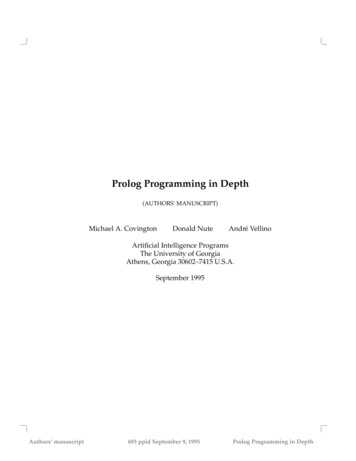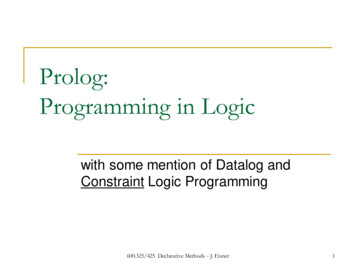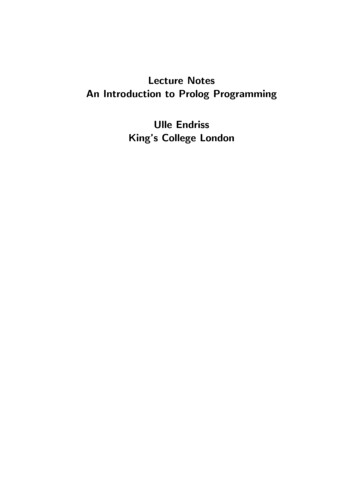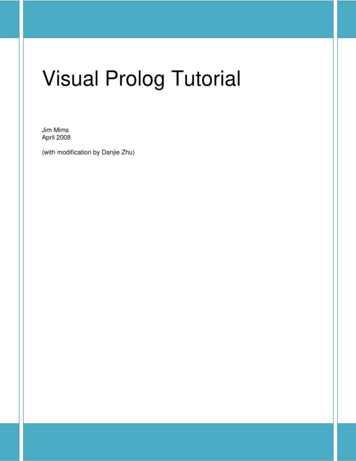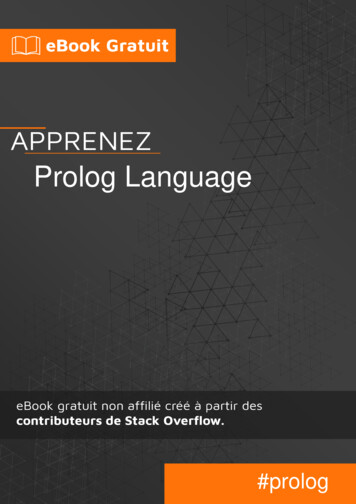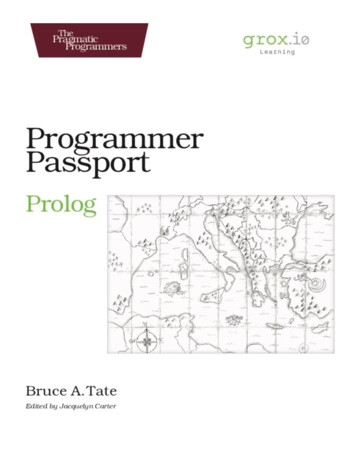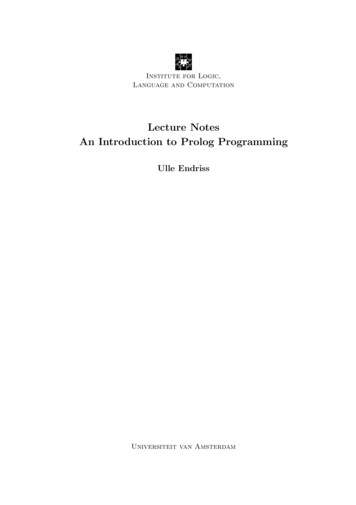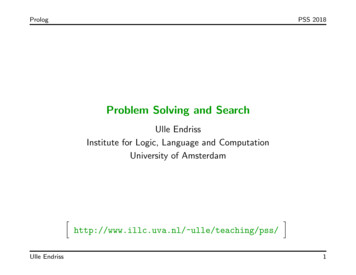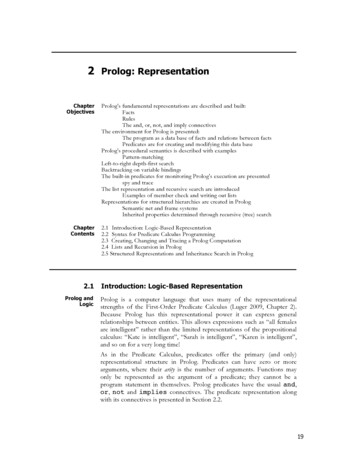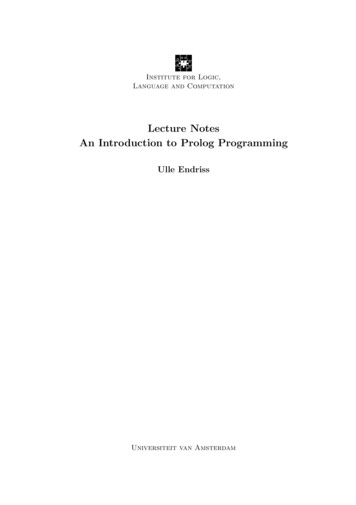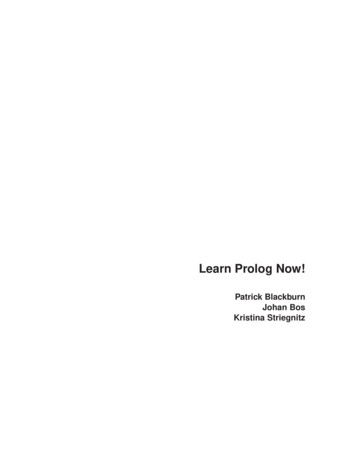
Transcription
Learn Prolog Now!Patrick BlackburnJohan BosKristina Striegnitz
Copyright c by Patrick Blackburn, Johan Bos and Kristina Striegnitz, .uni-sb.deThis course is also available online:http://www.coli.uni-sb.de/ kris/learn-prolog-now
Contents1 Facts, Rules, and Queries11.1 Some simple examples . . . . . . . . . . . . . . . . . . . . . . . .11.1.1 Knowledge Base 1 . . . . . . . . . . . . . . . . . . . . . .11.1.2 Knowledge Base 2 . . . . . . . . . . . . . . . . . . . . . .31.1.3 Knowledge Base 3 . . . . . . . . . . . . . . . . . . . . . .41.1.4 Knowledge Base 4 . . . . . . . . . . . . . . . . . . . . . .61.1.5 Knowledge Base 5 . . . . . . . . . . . . . . . . . . . . . .81.2 Prolog Syntax . . . . . . . . . . . . . . . . . . . . . . . . . . . . .81.2.1 Atoms . . . . . . . . . . . . . . . . . . . . . . . . . . . . .91.2.2 Numbers . . . . . . . . . . . . . . . . . . . . . . . . . . . .91.2.3 Variables . . . . . . . . . . . . . . . . . . . . . . . . . . . .91.2.4 Complex terms . . . . . . . . . . . . . . . . . . . . . . . .101.3 Exercises . . . . . . . . . . . . . . . . . . . . . . . . . . . . . . . .111.4 Practical Session 1 . . . . . . . . . . . . . . . . . . . . . . . . . .132 Matching and Proof Search172.1 Matching . . . . . . . . . . . . . . . . . . . . . . . . . . . . . . . .172.1.1 Examples . . . . . . . . . . . . . . . . . . . . . . . . . . .192.1.2 The occurs check . . . . . . . . . . . . . . . . . . . . . . .222.1.3 Programming with matching . . . . . . . . . . . . . . . . .232.2 Proof Search . . . . . . . . . . . . . . . . . . . . . . . . . . . . . .262.3 Exercises . . . . . . . . . . . . . . . . . . . . . . . . . . . . . . . .312.4 Practical Session 2 . . . . . . . . . . . . . . . . . . . . . . . . . .33
3 Recursion373.1 Recursive definitions . . . . . . . . . . . . . . . . . . . . . . . . .373.1.1 Example 1: Eating . . . . . . . . . . . . . . . . . . . . . .373.1.2 Example 2: Descendant . . . . . . . . . . . . . . . . . . .403.1.3 Example 3: Successor . . . . . . . . . . . . . . . . . . . .433.1.4 Example 3: Addition . . . . . . . . . . . . . . . . . . . . .453.2 Clause ordering, goal ordering, and termination . . . . . . . . .473.3 Exercises . . . . . . . . . . . . . . . . . . . . . . . . . . . . . . . .493.4 Practical Session 3 . . . . . . . . . . . . . . . . . . . . . . . . . .514 Lists554.1 Lists . . . . . . . . . . . . . . . . . . . . . . . . . . . . . . . . . . .554.2 Member . . . . . . . . . . . . . . . . . . . . . . . . . . . . . . . . .594.3 Recursing down lists . . . . . . . . . . . . . . . . . . . . . . . . .614.4 Exercises . . . . . . . . . . . . . . . . . . . . . . . . . . . . . . . .654.5 Practical Session 4 . . . . . . . . . . . . . . . . . . . . . . . . . .665 Arithmetic695.1 Arithmetic in Prolog . . . . . . . . . . . . . . . . . . . . . . . . . .695.2 A closer look . . . . . . . . . . . . . . . . . . . . . . . . . . . . . .715.3 Arithmetic and lists . . . . . . . . . . . . . . . . . . . . . . . . . .735.4 Comparing integers . . . . . . . . . . . . . . . . . . . . . . . . . .755.5 Exercises . . . . . . . . . . . . . . . . . . . . . . . . . . . . . . . .785.6 Practical Session 5 . . . . . . . . . . . . . . . . . . . . . . . . . .796 More Lists816.1 Append . . . . . . . . . . . . . . . . . . . . . . . . . . . . . . . . .816.1.1 Defining append . . . . . . . . . . . . . . . . . . . . . . .826.1.2 Using append . . . . . . . . . . . . . . . . . . . . . . . . .846.2 Reversing a list . . . . . . . . . . . . . . . . . . . . . . . . . . . .876.2.1 Naive reverse using append . . . . . . . . . . . . . . . . .876.2.2 Reverse using an accumulator . . . . . . . . . . . . . . .886.3 Exercises . . . . . . . . . . . . . . . . . . . . . . . . . . . . . . . .896.4 Practical Session 6 . . . . . . . . . . . . . . . . . . . . . . . . . .90
7 Definite Clause Grammars937.1 Context free grammars . . . . . . . . . . . . . . . . . . . . . . . .937.1.1 CFG recognition using append . . . . . . . . . . . . . . .957.1.2 CFG recognition using difference lists . . . . . . . . . . .987.2 Definite clause grammars . . . . . . . . . . . . . . . . . . . . . . 1007.2.1 A first example . . . . . . . . . . . . . . . . . . . . . . . . 1007.2.2 Adding recursive rules . . . . . . . . . . . . . . . . . . . . 1027.2.3 A DCG for a simple formal language . . . . . . . . . . . . 1047.3 Exercises . . . . . . . . . . . . . . . . . . . . . . . . . . . . . . . . 1057.4 Practical Session 7 . . . . . . . . . . . . . . . . . . . . . . . . . . 1068 More Definite Clause Grammars1098.1 Extra arguments . . . . . . . . . . . . . . . . . . . . . . . . . . . . 1098.1.1 Context free grammars with features . . . . . . . . . . . . 1098.1.2 Building parse trees . . . . . . . . . . . . . . . . . . . . . 1148.1.3 Beyond context free languages . . . . . . . . . . . . . . . 1178.2 Extra goals . . . . . . . . . . . . . . . . . . . . . . . . . . . . . . . 1188.2.1 Separating rules and lexicon . . . . . . . . . . . . . . . . 1198.3 Concluding remarks . . . . . . . . . . . . . . . . . . . . . . . . . . 1218.4 Exercises . . . . . . . . . . . . . . . . . . . . . . . . . . . . . . . . 1228.5 Practical Session 8 . . . . . . . . . . . . . . . . . . . . . . . . . . 1229 A Closer Look at Terms1259.1 Comparing terms . . . . . . . . . . . . . . . . . . . . . . . . . . . 1259.2 Terms with a special notation . . . . . . . . . . . . . . . . . . . . 1279.2.1 Arithmetic terms . . . . . . . . . . . . . . . . . . . . . . . 1279.2.2 Lists as terms . . . . . . . . . . . . . . . . . . . . . . . . . 1299.3 Examining Terms . . . . . . . . . . . . . . . . . . . . . . . . . . . 1319.3.1 Types of Terms . . . . . . . . . . . . . . . . . . . . . . . . 1319.3.2 The Structure of Terms . . . . . . . . . . . . . . . . . . . . 1339.4 Operators . . . . . . . . . . . . . . . . . . . . . . . . . . . . . . . . 1369.4.1 Properties of operators . . . . . . . . . . . . . . . . . . . . 1369.4.2 Defining operators . . . . . . . . . . . . . . . . . . . . . . 1379.5 Exercises . . . . . . . . . . . . . . . . . . . . . . . . . . . . . . . . 1389.6 Practical Session . . . . . . . . . . . . . . . . . . . . . . . . . . . 140
10 Cuts and Negation14510.1 The cut . . . . . . . . . . . . . . . . . . . . . . . . . . . . . . . . . 14510.2 If-then-else . . . . . . . . . . . . . . . . . . . . . . . . . . . . . . . 15210.3 Negation as failure . . . . . . . . . . . . . . . . . . . . . . . . . . 15210.4 Exercises . . . . . . . . . . . . . . . . . . . . . . . . . . . . . . . . 15610.5 Practical Session 10 . . . . . . . . . . . . . . . . . . . . . . . . . 15611 Database Manipulation and Collecting Solutions15911.1 Database manipulation . . . . . . . . . . . . . . . . . . . . . . . . 15911.2 Collecting solutions . . . . . . . . . . . . . . . . . . . . . . . . . . 16411.2.1 findall/3 . . . . . . . . . . . . . . . . . . . . . . . . . . . 16411.2.2 bagof/3 . . . . . . . . . . . . . . . . . . . . . . . . . . . . 16511.2.3 setof/3 . . . . . . . . . . . . . . . . . . . . . . . . . . . . 16711.3 Exercises . . . . . . . . . . . . . . . . . . . . . . . . . . . . . . . . 16811.4 Practical Session 11 . . . . . . . . . . . . . . . . . . . . . . . . . 17012 Working With Files17112.1 Splitting Programs Over Files . . . . . . . . . . . . . . . . . . . . 17112.1.1 Reading in Programs . . . . . . . . . . . . . . . . . . . . . 17112.1.2 Modules . . . . . . . . . . . . . . . . . . . . . . . . . . . . 17212.1.3 Libraries . . . . . . . . . . . . . . . . . . . . . . . . . . . . 17412.2 Writing To and Reading From Files . . . . . . . . . . . . . . . . . 17412.3 Practical Session . . . . . . . . . . . . . . . . . . . . . . . . . . . 17612.3.1 Step 1 . . . . . . . . . . . . . . . . . . . . . . . . . . . . . 17612.3.2 Step 2 . . . . . . . . . . . . . . . . . . . . . . . . . . . . . 17612.3.3 Step 3 . . . . . . . . . . . . . . . . . . . . . . . . . . . . . 17612.3.4 Step 4 . . . . . . . . . . . . . . . . . . . . . . . . . . . . . 17712.3.5 Step 5 . . . . . . . . . . . . . . . . . . . . . . . . . . . . . 17712.3.6 Step 6 . . . . . . . . . . . . . . . . . . . . . . . . . . . . . 177
1Facts, Rules, and QueriesThis introductory lecture has two main goals:1. To give some simple examples of Prolog programs. This will introduce us to thethree basic constructs in Prolog: facts, rules, and queries. It will also introduceus to a number of other themes, like the role of logic in Prolog, and the idea ofperforming matching with the aid of variables.2. To begin the systematic study of Prolog by defining terms, atoms, variables andother syntactic concepts.1.1Some simple examplesThere are only three basic constructs in Prolog: facts, rules, and queries. A collectionof facts and rules is called a knowledge base (or a database) and Prolog programmingis all about writing knowledge bases. That is, Prolog programs simply are knowledgebases, collections of facts and rules which describe some collection of relationshipsthat we find interesting. So how do we use a Prolog program? By posing queries. Thatis, by asking questions about the information stored in the knowledge base. Now thisprobably sounds rather strange. It’s certainly not obvious that it has much to do withprogramming at all – after all, isn’t programming all about telling the computer whatto do? But as we shall see, the Prolog way of programming makes a lot of sense, atleast for certain kinds of applications (computational linguistics being one of the mostimportant examples). But instead of saying more about Prolog in general terms, let’sjump right in and start writing some simple knowledge bases; this is not just the bestway of learning Prolog, it’s the only way .1.1.1Knowledge Base 1Knowledge Base 1 (KB1) is simply a collection of facts. Facts are used to state thingsthat are unconditionally true of the domain of interest. For example, we can state thatMia, Jody, and Yolanda are women, and that Jody plays air guitar, using the followingfour irGuitar(jody).
2Chapter 1. Facts, Rules, and QueriesThis collection of facts is KB1. It is our first example of a Prolog program. Note thatthe names mia, jody, and yolanda, and the properties woman and playsAirGuitar,have been written so that the first letter is in lower-case. This is important; we will seewhy a little later.How can we use KB1? By posing queries. That is, by asking questions about theinformation KB1 contains. Here are some examples. We can ask Prolog whether Miais a woman by posing the query:?- woman(mia).Prolog will answeryesfor the obvious reason that this is one of the facts explicitly recorded in KB1. Incidentally, we don’t type in the ?-. This symbol (or something like it, depending on theimplementation of Prolog you are using) is the prompt symbol that the Prolog interpreter displays when it is waiting to evaluate a query. We just type in the actual query(for example woman(mia)) followed by . (a full stop).Similarly, we can ask whether Jody plays air guitar by posing the following query:?- playsAirGuitar(jody).Prolog will again answer “yes”, because this is one of the facts in KB1. However,suppose we ask whether Mia plays air guitar:?- playsAirGuitar(mia).We will get the answernoWhy? Well, first of all, this is not a fact in KB1. Moreover, KB1 is extremely simple,and contains no other information (such as the rules we will learn about shortly) whichmight help Prolog try to infer (that is, deduce whether Mia plays air guitar. So Prologcorrectly concludes that playsAirGuitar(mia) does not follow from KB1.Here are two important examples. Suppose we pose the query:?- playsAirGuitar(vincent).Again Prolog answers “no”. Why? Well, this query is about a person (Vincent) that ithas no information about, so it concludes that playsAirGuitar(vincent) cannot bededuced from the information in KB1.Similarly, suppose we pose the query:?- tatooed(jody).Again Prolog will answer “no”. Why? Well, this query is about a property (beingtatooed) that it has no information about, so once again it concludes that the querycannot be deduced from the information in KB1.
1.1. Some simple examples1.1.23Knowledge Base 2Here is KB2, our second knowledge itar(mia) :- listensToMusic(mia).playsAirGuitar(yolanda) :- listensToMusic(yolanda).listensToMusic(yolanda):- happy(yolanda).KB2 contains two facts, listensToMusic(mia) and happy(yolanda). The last threeitems are rules.Rules state information that is conditionally true of the domain of interest. For example, the first rule says that Mia plays air guitar if she listens to music, and the last rulesays that Yolanda listens to music if she if happy. More generally, the :- should beread as “if”, or “is implied by”. The part on the left hand side of the :- is called thehead of the rule, the part on the right hand side is called the body. So in general rulessay: if the body of the rule is true, then the head of the rule is true too. And now forthe key point: if a knowledge base contains a rule head :- body, and Prolog knowsthat body follows from the information in the knowledge base, then Prolog can inferhead.This fundamental deduction step is what logicians call modus ponens.Let’s consider an example. We will ask Prolog whether Mia plays air guitar:?- playsAirGuitar(mia).Prolog will respond “yes”. Why? Well, although playsAirGuitar(mia) is not a factexplicitly recorded in KB2, KB2 does contain the ruleplaysAirGuitar(mia) :- listensToMusic(mia).Moreover, KB2 also contains the fact listensToMusic(mia). Hence Prolog can usemodus ponens to deduce that playsAirGuitar(mia).Our next example shows that Prolog can chain together uses of modus ponens. Supposewe ask:?- playsAirGuitar(yolanda).Prolog would respond “yes”. Why? Well, using the fact happy(yolanda) and the rulelistensToMusic(yolanda):- happy(yolanda),Prolog can deduce the new fact listensToMusic(yolanda). This new fact is notexplicitly recorded in the knowledge base — it is only implicitly present (it is inferredknowledge). Nonetheless, Prolog can then use it just like an explicitly recorded fact.Thus, together with the rule
4Chapter 1. Facts, Rules, and QueriesplaysAirGuitar(yolanda) :- listensToMusic(yolanda)it can deduce that playsAirGuitar(yolanda), which is what we asked it. Summingup: any fact produced by an application of modus ponens can be used as input to furtherrules. By chaining together applications of modus ponens in this way, Prolog is ableto retrieve information that logically follows from the rules and facts recorded in theknowledge base.The facts and rules contained in a knowledge base are called clauses. Thus KB2 contains five clauses, namely three rules and two facts. Another way of looking at KB2 isto say that it consists of three predicates (or procedures). The three predicates are:listensToMusichappyplaysAirGuitarThe happy predicate is defined using a single clause (a fact). The listensToMusicand playsAirGuitar predicates are each defined using two clauses (in both cases, tworules). It is a good idea to think about Prolog programs in terms of the predicates theycontain. In essence, the predicates are the concepts we find important, and the variousclauses we write down concerning them are our attempts to pin down what they meanand how they are inter-related.One final remark. We can view a fact as a rule with an empty body. That is, wecan think of facts as “conditionals that do not have any antecedent conditions”, or“degenerate rules”.1.1.3Knowledge Base 3KB3, our third knowledge base, consists of five rGuitar(butch):listensToMusic(butch).There are two facts, namely happy(vincent) and listensToMusic(butch), andthree rules.KB3 defines the same three predicates as KB2 (namely happy, listensToMusic, andplaysAirGuitar) but it defines them differently. In particular, the three rules thatdefine the playsAirGuitar predicate introduce some new ideas. First, note that therule
1.1. Some simple ncent),happy(vincent).has two items in its body, or (to use the standard terminology) two goals. What doesthis rule mean? The important thing to note is the comma , that separates the goallistensToMusic(vincent) and the goal happy(vincent) in the rule’s body. This isthe way logical conjunction is expressed in Prolog (that is, the comma means and). Sothis rule says: “Vincent plays air guitar if he listens to music and he is happy”.Thus, if we posed the query?- playsAirGuitar(vincent).Prolog would answer “no”. This is because while KB3 contains happy(vincent), itdoes not explicitly contain the information listensToMusic(vincent), and this factcannot be deduced either. So KB3 only fulfils one of the two preconditions needed toestablish playsAirGuitar(vincent), and our query fails.Incidentally, the spacing used in this rule is irrelevant. For example, we could havewritten it asplaysAirGuitar(vincent):- happy(vincent),listensToMusic(vincent).and it would have meant exactly the same thing. Prolog offers us a lot of freedom inthe way we set out knowledge bases, and we can take advantage of this to keep ourcode readable.Next, note that KB3 contains two rules with exactly the same head, Guitar(butch):listensToMusic(butch).This is a way of stating that Butch plays air guitar if either he listens to music, or ifhe is happy. That is, listing multiple rules with the same head is a way of expressinglogical disjunction (that is, it is a way of saying or). So if we posed the query?- playsAirGuitar(butch).Prolog would answer “yes”. For although the first of these rules will not help (KB3does not allow Prolog to conclude that happy(butch)), KB3 does contain listensToMusic(butch)and this means Prolog can apply modus ponens using the ruleplaysAirGuitar(butch):listensToMusic(butch).
6Chapter 1. Facts, Rules, and Queriesto conclude that playsAirGuitar(butch).There is another way of expressing disjunction in Prolog. We could replace the pair ofrules given above by the single sic(butch).That is, the semicolon ; is the Prolog symbol for or, so this single rule means exactlythe same thing as the previous pair of rules. But Prolog programmers usually writemultiple rules, as extensive use of semicolon can make Prolog code hard to read.It should now be clear that Prolog has something do with logic: after all, the :- meansimplication, the , means conjunction, and the ; means disjunction. (What about negation? That is a whole other story. We’ll be discussing it later in the course.) Moreover,we have seen that a standard logical proof rule (modus ponens) plays an important rolein Prolog programming. And in fact “Prolog” is short for “Programming in logic”.1.1.4Knowledge Base 4Here is KB4, our fourth knowledge ey bunny).loves(honey bunny,pumpkin).Now, this is a pretty boring knowledge base. There are no rules, only a collection offacts. Ok, we are seeing a relation that has two names as arguments for the first time(namely the loves relation), but, let’s face it, that’s a rather predictable idea.No, the novelty this time lies not in the knowledge base, it lies in the queries we aregoing to pose. In particular, for the first time we’re going to make use of variables.Here’s an example:?- woman(X).The X is a variable (in fact, any word beginning with an upper-case letter is a Prologvariable, which is why we had to be careful to use lower-case initial letters in our earlierexamples). Now a variable isn’t a name, rather it’s a “placeholder” for information.That is, this query essentially asks Prolog: tell me which of the individuals you knowabout is a woman.Prolog answers this query by working its way through KB4, from top to bottom, tryingto match (or unify) the expression woman(X) with the information KB4 contains. Now
1.1. Some simple examples7the first item in the knowledge base is woman(mia). So, Prolog matches X to mia,thus making the query agree perfectly with this first item. (Incidentally, there’s a lotof different terminology for this process: we can also say that Prolog instantiates X tomia, or that it binds X to mia.) Prolog then reports back to us as follows:X miaThat is, it not only says that there is information about at least one woman in KB4,it actually tells us who she is. It didn’t just say “yes”, it actually gave us the variablebinding, or instantiation that led to success.But that’s not the end of the story. The whole point of variables — and not just inProlog either — is that they can “stand for” or “match with” different things. Andthere is information about other women in the knowledge base. We can access thisinformation by typing the following simple query?-;Remember that ; means or, so this query means: are there any more women? SoProlog begins working through the knowledge base again (it remembers where it gotup to last time and starts from there) and sees that if it matches X with jody, then thequery agrees perfectly with the second entry in the knowledge base. So it responds:X jodyIt’s telling us that there is information about a second woman in KB4, and (once again)it actually gives us the value that led to success. And of course, if we press ; a secondtime, Prolog returns the answerX yolandaBut what happens if we press ; a third time? Prolog responds “no”. No other matchesare possible. There are no other facts starting with the symbol woman. The last fourentries in the knowledge base concern the love relation, and there is no way that suchentries can match a query of the form of the form woman(x).Let’s try a more complicated query, namelyloves(marcellus,X),woman(X).Now, remember that , means and, so this query says: is there any individual X suchthat Marcellus loves X and X is a woman? If you look at the knowledge base you’ll seethat there is: Mia is a woman (fact 1) and Marcellus loves Mia (fact 5). And in fact,Prolog is capable of working this out. That is, it can search through the knowledgebase and work out that if it matches X with Mia, then both conjuncts of the query aresatisfied (we’ll learn in later lectures exactly how Prolog does this). So Prolog returnsthe answerX miaThis business of matching variables to information in the knowledge base is the heartof Prolog. For sure, Prolog has many other interesting aspects — but when you getright down to it, it’s Prolog’s ability to perform matching and return the values of thevariable binding to us that is crucial.
81.1.5Chapter 1. Facts, Rules, and QueriesKnowledge Base 5Well, we’ve introduced variables, but so far we’ve only used them in queries. In fact,variables not only can be used in knowledge bases, it’s only when we start to do so thatwe can write truly interesting programs. Here’s a simple example, the knowledge ves(pumpkin,honey bunny).loves(honey bunny,pumpkin).jealous(X,Y) :- loves(X,Z),loves(Y,Z).KB5 contains four facts about the loves relation and one rule. (Incidentally, the blankline between the facts and the rule has no meaning: it’s simply there to increase thereadability. As we said earlier, Prolog gives us a great deal of freedom in the way weformat knowledge bases.) But this rule is by far the most interesting one we have seenso far: it contains three variables (note that X, Y, and Z are all upper-case letters). Whatdoes it say?In effect, it is defining a concept of jealousy. It says that an individual X will be jealousof an individual Y if there is some individual Z that X loves, and Y loves that sameindividual Z too. (Ok, so jealously isn’t as straightforward as this in the real world .)The key thing to note is that this is a general statement: it is not stated in terms of mia,or pumpkin, or anyone in particular — it’s a conditional statement about everybody inour little world.Suppose we pose the query:?- jealous(marcellus,W).This query asks: can you find an individual W such that Marcellus is jealous of W?Vincent is such an individual. If you check the definition of jealousy, you’ll see thatMarcellus must be jealous of Vincent, because they both love the same woman, namelyMia. So Prolog will return the valueW vincentNow some questions for you, First, are there any other jealous people in KB5? Furthermore, suppose we wanted Prolog to tell us about all the jealous people: what querywould we pose? Do any of the answers surprise you? Do any seem silly?1.2Prolog SyntaxNow that we’ve got some idea of what Prolog does, it’s time to go back to the beginningand work through the details more carefully. Let’s start by asking a very basic question:we’ve seen all kinds of expressions (for example jody, playsAirGuitar(mia), and
1.2. Prolog Syntax9X) in our Prolog programs, but these have just been examples. Exactly what are facts,rules, and queries built out of?The answer is terms, and there are four kinds of terms in Prolog: atoms, numbers,variables, and complex terms (or structures). Atoms and numbers are lumped togetherunder the heading constants, and constants and variables together make up the simpleterms of Prolog.Let’s take a closer look. To make things crystal clear, let’s first get clear about thebasic characters (or symbols) at our disposal. The upper-case letters are A, B, ., Z; thelower-case letters are a, b, ., z; the digits are 1, 2, ., 9; and the special charactersare , -, *, /, , , , :, ., &, , and . The character is called underscore. Theblank space is also a character, but a rather unusual one, being invisible. A string is anunbroken sequence of characters.1.2.1AtomsAn atom is either:1. A string of characters made up of upper-case letters, lower-case letters, digits,and the underscore character, that begins with a lower-case letter. For example:butch, big kahuna burger, and m monroe2.2. An arbitrary sequence of character enclosed in single quotes. For example ’Vincent’,’The Gimp’, ’Five Dollar Shake’, ’& %&#@ &*’, and ’ ’. The character between the single quotes is called the atom name. Note that we are allowed to usespaces in such atoms — in fact, a common reason for using single quotes is sowe can do precisely that.3. A string of special characters. For example: @ and and ; and :- areall atoms. As we have seen, some of these atoms, such as ; and :- have apre-defined meaning.1.2.2NumbersReal numbers aren’t particularly important in typical Prolog applications. So althoughmost Prolog implementations do support floating point numbers or floats (that is, representations of real numbers such as 1657.3087 or π) we are not going to discuss themin this course.But integers (that is: . -2, -1, 0, 1, 2, 3, .) are useful for such tasks as counting theelements of a list, and we’ll discuss how to manipulate them in a later lecture. TheirProlog syntax is the obvious one: 23, 1001, 0, -365, and so on.1.2.3VariablesA variable is a string of upper-case letters, lower-case letters, digits and underscorecharacters that starts either with an upper-case letter or with underscore. For example,X, Y, Variable, tag, X 526, and List, List24, head, Tail, input and Outputare all Prolog variables.The variable (that is, a single underscore character) is rather special. It’s called theanonymous variable, and we discuss it in a later lecture.
101.2.4Chapter 1. Facts, Rules, and QueriesComplex termsConstants, numbers, and variables are the building blocks: now we need to know howto fit them together to make complex terms. Recall that complex terms are often calledstructures.Complex terms are build out of a functor followed by a sequence of arguments. Thearguments are put in ordinary brackets, separated by commas, and placed after thefunctor. The functor must be an atom. That is, variables cannot be used as functors.On the other hand, arguments can be any kind of term.Now, we’ve already seen lots of examples of complex terms when we looked at KB1– KB5. For example, playsAirGuitar(jody) is a complex term: its functor isplaysAirGuitar and its argument is jody. Other examples are loves(vincent,mia)and, to give an example containing a variable, jealous(marcellus,W).But note that the definition allows far more complex terms than this. In fact, it allowsus to to keep nesting complex terms inside complex terms indefinitely (that is, it is arecursive definition). For examplehide(X,father(father(father(butch))))is a perfectly ok complex term. Its functor is hide, and it has two arguments: the variable X, and the complex term father(father(father(butch))). This complex termhas father as its functor, and another complex term, namely father(father(butch)),as its sole argument. And the argument of this complex term, namely father(butch),is also complex. But then the nesting “bottoms out”, for the argument here is the constant butch.As we shall see, such nested (or recursively structured) terms enable us to representmany problems naturally. In fact the interplay between recursive term structure andvariable matching is the source of much of Prolog’s power.The number of arguments that a complex term has is called its arity. For instance,woman(mia) is a complex term with arity 1, while loves(vincent,mia) is a complexterm with arity 2.Arity is important to Prolog. Prolog would be quite happy for us to define two predicates with the same functor but with a different number of arguments. For example,we are free to define a knowledge base that defines a two place predicate love (thismight contain such facts as love(vincent,mia)), and also a three place love predicate (which might contain such facts as love(vincent,marcellus,mia)). However,if we did this, Prolog would tre
three basic constructs in Prolog: facts, rules, and queries. It will also introduce us to a number of other themes, like the role of logic in Prolog, and the idea of performing matching with the aid of variables. 2. To begin the systematic study of Prolog by defining terms, atoms, variables and other syntactic concepts. 1.1 Some simple examples
